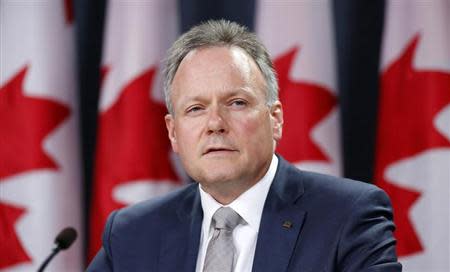Bank of Canada cuts third quarter growth forecast as exports sluggish

By Leah Schnurr TORONTO (Reuters) - The Bank of Canada cut its third-quarter economic growth forecast sharply on Tuesday and said the crucial export sector might recover more slowly than expected, making clear interest rates will remain low until the outlook improves. Senior Deputy Governor Tiff Macklem said the central bank now expects annualized growth in the third and fourth quarters to be in the 2 to 2.5 percent range before strengthening next year. In its monetary policy report released in July, the bank said third-quarter growth would be 3.8 percent and fourth-quarter growth would be 2.5 percent. "Near-term growth now looks a little less choppy than initially projected," Macklem said. The bank's July projections overestimated the second-quarter impact on growth of severe flooding in Alberta and a construction strike in Quebec, both in June. The economy grew 1.7 percent in the second quarter, compared with the bank's estimate of 1 percent. Macklem said the economy must grow by at least 2.5 percent to put a meaningful dent in excess slack. This suggests that process will not start until 2014. Stating a goal for the growth rates gives markets extra guidance on the timing of the bank's next interest rate hike. The rare level of detail provided in Macklem's outlook marks a departure by the bank from its usual practice of refraining from making even broad-stroke forecasts in speeches, much less in statements by deputies. "It is now clear that from a Bank of Canada point of view, excess slack is not expected to begin being absorbed before early 2014, and that is at the earliest," said Jimmy Jean, an economic strategist at Desjardins Capital Markets. "Most likely, this implies a longer horizon for the output gap's closure," he said. The bank will publish more detailed forecasts in its next quarterly update on October 23. The bank has kept its key interest rate unchanged at 1 percent, a near-record low, since September 2010. "With inflation subdued, monetary policy remains highly stimulative to provide time for the recovery in exports and investment to take hold," Macklem said. Forecasters in a Reuters poll conducted in August predicted the bank would begin raising rates in the fourth quarter of 2014. Canada recovered quickly from the 2008-09 recession, largely due to strong consumer spending and a housing boom. But with the household debt-to-income ratio at a record high because of low interest rates, policymakers are eager to see consumers take a backseat while businesses, particularly exporters, pick up the slack. The bank expects, in general, household and government spending combined to contribute about 1.5 percentage points of growth. To reach the targeted 2.5 percent growth, net exports and investment would need to contribute at least 1 percentage point. "That means together exports and investment need to grow by at least about 4 percent after taking into account their import content," Macklem said. In the past year, net exports and investment in fact contributed nothing to growth, he said. IMPACT OF U.S. SHUTDOWN On the economic impact on Canada of the U.S. government shutdown after lawmakers failed to agree on a budget, Macklem said: "The short answer is the uncertainty that this ongoing brinkmanship is bringing is not helpful." The impact will be relatively small if the shutdown is short-lived, he said, but a longer paralysis like the one in 1995-96 could have more serious implications. "If you look at the market response you can see today it's relatively muted, which means the market is assuming, hoping this will be relatively short-lived," he said. "Certainly if it does last a long time. At the end of '95 into early '96 there was a 28-day shutdown and that did have a measurable impact, so it certainly could happen." Macklem said a predicted shift in demand in Canada toward exports and business investment - important to help ensure a healthier economic growth rate and reduce reliance on consumer spending - had proved elusive. "There is a risk that this rotation is delayed further," he said. Exporters have lost competitiveness since 2000 in large part because of the appreciation of the Canadian dollar versus the greenback, Macklem said. That currency strength is one of the reasons the Bank of Canada has kept interest rates so low for so long, he said in a response to a question from the audience after the speech. (Additional reporting by Louise Egan and David Ljunggren; Editing by Jeffrey Hodgson and Dan Grebler)

